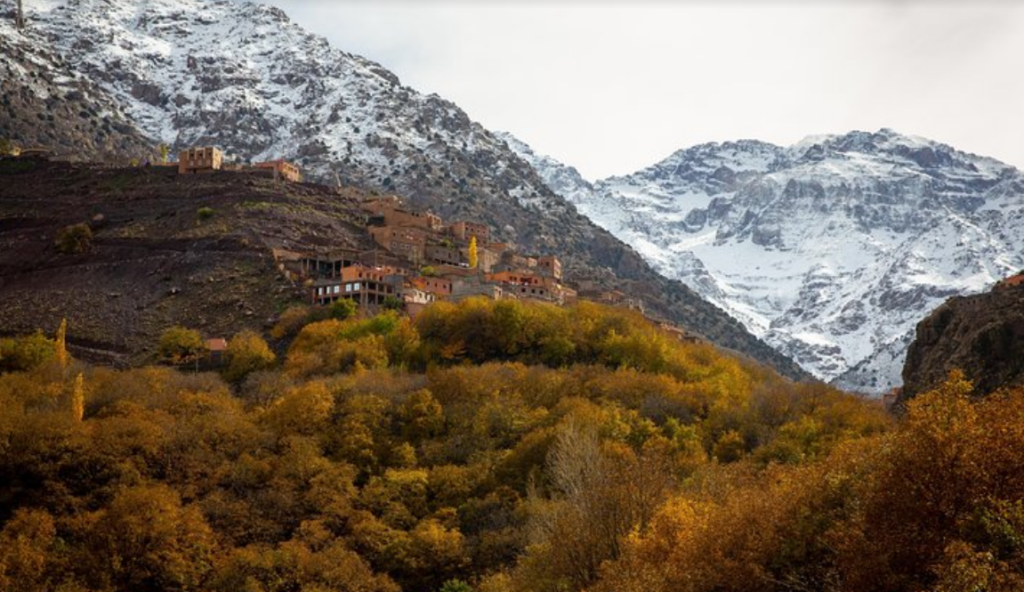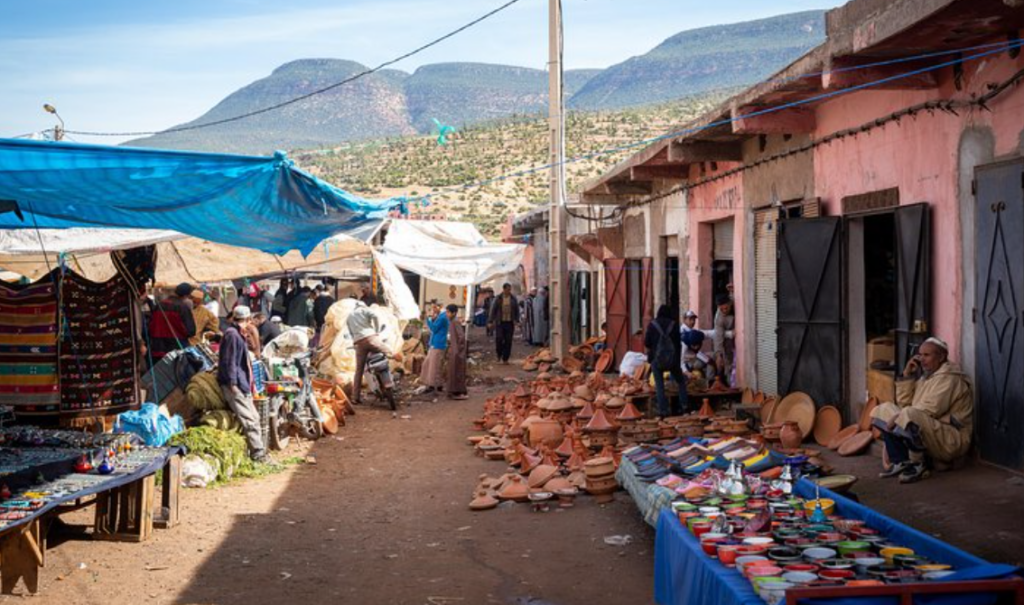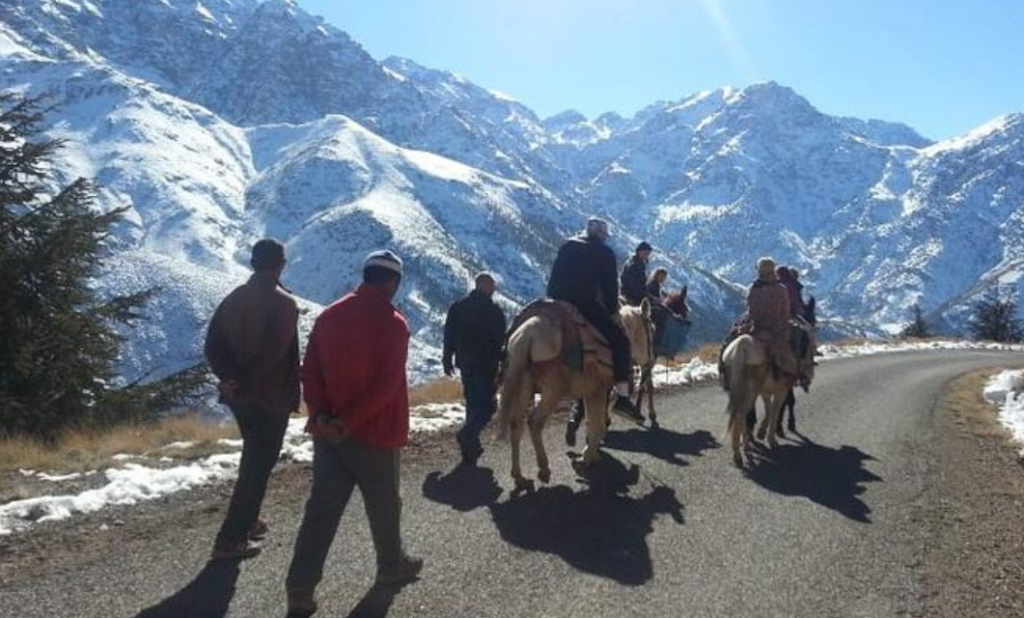Nestled at the foot of the Atlas Mountains in Morocco, Marrakech, often referred to as the “Red City” for its stunning terracotta walls, is a destination that beckons adventure, culture, food and history alike. This enchanting city seamlessly blends the old with the new, creating a travel experience that is timeless and modern. My favourite country in the world so far, join me as we explore the sights, sounds, and flavours of Marrakech that make it so special.
Marrakech’s history stretches back a thousand years, and its rich cultural heritage is evident throughout the city. The medina, a UNESCO World Heritage site, is the heart of Marrakech and a prime example of its historical significance. But we aren’t here to learn about the history of Jemaa el-Fnaa just yet, we are here to get lost in its labyrinth of alleys and souks (markets), and wonderful characters. In Marrakesh you’ll find ancient palaces, mosques, and gardens, all testament to the city’s former glory as the capital of the Almoravid Empire. One of the city’s most iconic landmarks is the Koutoubia Mosque, known for its impressive minaret that has become a symbol of Marrakech. While non-Muslims are not allowed inside the mosque, the surrounding gardens offer a peaceful place to admire its beauty.
Marrakesh to me is the beating heart of Morocco, where tradition meets vibrant modern energy in a whirlwind of colors, sounds, and scents! One minute you’re wandering through winding alleyways of ancient souks, where the air is rich with the aroma of exotic spices, sizzling street food, and the sweet scent of orange blossoms. Every corner reveals something new—a riot of handcrafted goods, snake charmers hypnotizing crowds, and the hum of lively marketplaces. The next minute you are by the city’s iconic red walls as they stand backdrop to an enchanting mix of history and exploration. All of this whilst the Atlas Mountains hover in the distance like a wallpaper to your adventure. Whether you’re sipping mint tea in a serene riad, haggling for treasures in the medina, or getting lost in the magic of Jemaa el-Fnaa square as night falls, Marrakesh will captivate your senses and leave you craving more of its mystical charm.
Here’s everything I recommend you get up to during your time in the Red City.
Jemaa el-Fnaa
The electrifying heart of Marrakesh, a sprawling square that pulses with life day and night. By day, it’s a lively spectacle of activity, where snake charmers sway to the rhythm of their flutes, henna artists offer traditional designs, and where herbs and spices fill the air with a scent that can be smelt miles away. The square is filled with the scent of fresh-squeezed orange juice from the colourful carts that dot around the square, while musicians and acrobats captivate crowds with their performances.
As the sun sets, Jemaa el-Fnaa undergoes a magical transformation. The square comes alive with an incredible open-air food market, where the aroma of grilled meats, steaming tagines, and fresh bread fills the air. Lantern-lit stalls wheel around offering everything from spicy harissa soup to delicate pastries dripping in honey. Musicians playing traditional Moroccan instruments, Gnawa performers, and lively drum circles create an enchanting soundtrack that fills the night air, this is a truly Moroccan experience.


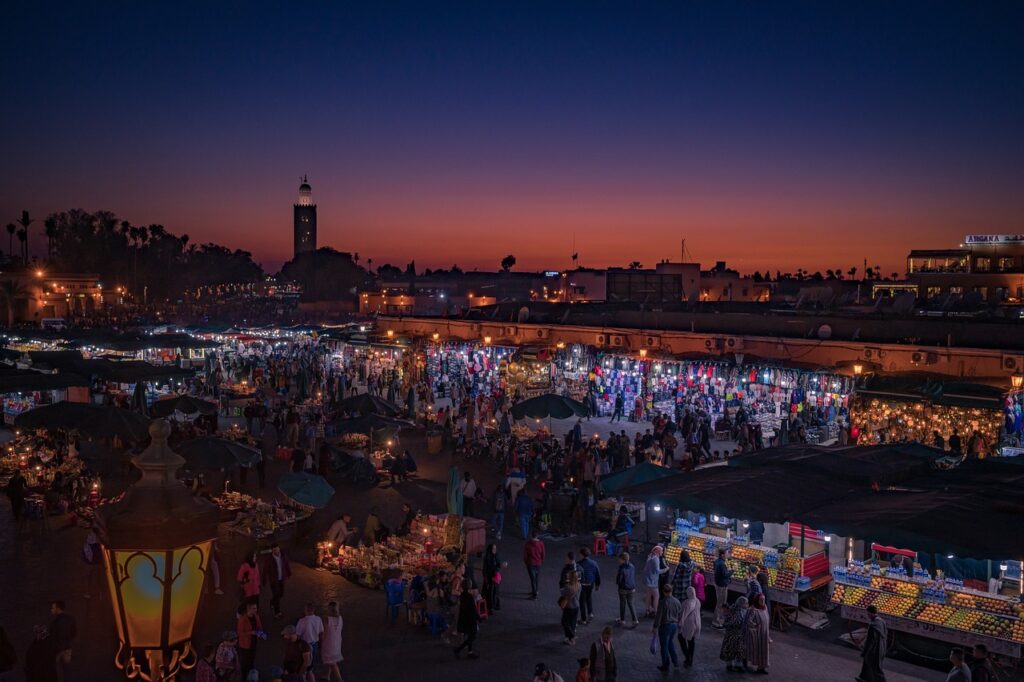
Souk Semmarine
One of the most vibrant and bustling markets in Marrakesh’s famous medina, and it’s an absolute must-visit for any traveller. As you step into this sprawling maze of shops and stalls, you’re instantly swept up in the energy of the people who bring it to life. The narrow, covered alleyways are lined with endless treasures—everything from handwoven carpets and leather goods to dazzling lanterns and vibrant ceramics. The souk is a feast for the eyes, with stalls overflowing with colourful textiles, traditional Moroccan slippers (babouches), genie lamps and beautifully crafted jewellery.
The atmosphere is an exhilarating mix of chatter, the scent of fresh spices, and the constant hammering of crafters at work. Whether you’re a seasoned haggler or just browsing, Souk Semmarine offers a sensory overload, with every twist and turn genuinely leading to something new. Expect to be greeted by friendly vendors calling you into their shops, each offering their own unique style of wager and willing to strike a bargain. For me, the souk is not just a market; it’s a truly different experience that plunges you into the very soul of Marrakesh’s vibrant culture.
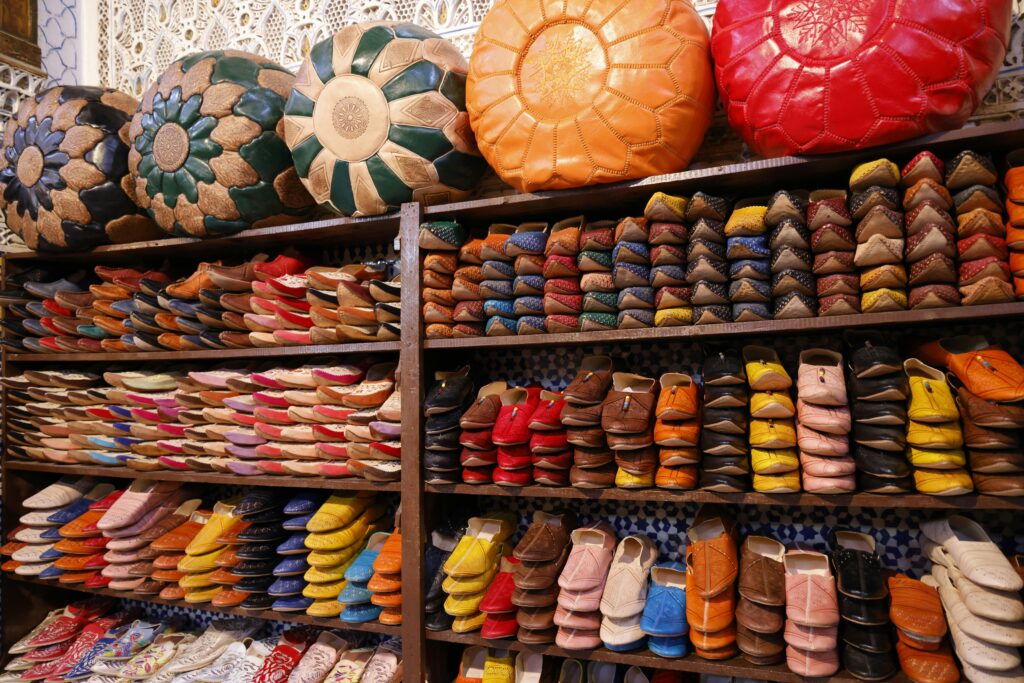
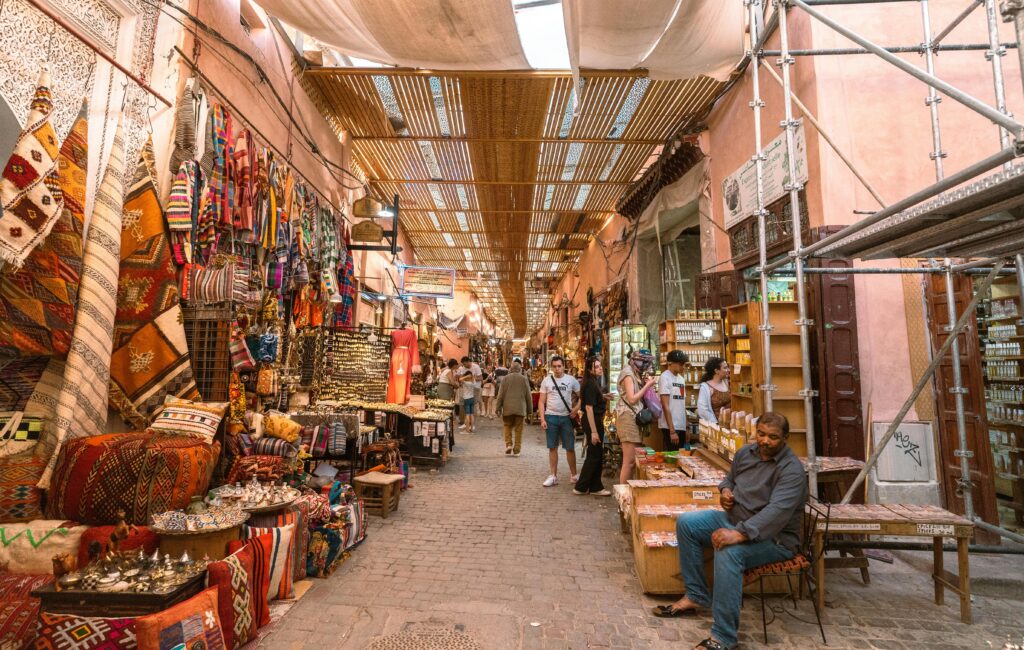
Koutoubia Mosque
Towering majestically over Marrakesh, is one of the city’s most iconic landmarks. Its elegant 70-meter-high minaret, visible from across the city, serves as both a symbol of Marrakesh and a guiding beacon for exploring the medina. Built in the 12th century under the Almohad dynasty, this stunning mosque is a masterpiece of Islamic architecture.
One for the history buffs, the name “Koutoubia” comes from the Arabic word for booksellers, as the mosque was once surrounded by manuscript vendors and scholars. Its beautifully preserved minaret is adorned with delicate stone carvings and topped with golden orbs that shine in the sunlight. The mosque itself is only accessible to Muslims, however the surrounding gardens are open to the public, offering a serene space filled with palm trees, fountains, and pathways where you can relax and soak in the tranquillity. As the call to prayer echoes around the city, the Koutoubia Mosque becomes a spiritual and cultural anchor in Marrakesh, reminding us of the city’s rich history and deep-rooted religious heritage.

Badi Palace
The Badi Palace in Marrakesh, once a glittering symbol of wealth and power, is now a simple ruin that shows of Morocco’s royal past. Built in the late 16th century by Sultan Ahmad al-Mansur of the Saadian dynasty, this “Incomparable Palace” was meant to dazzle visitors with its luxury. The sultan spared no expense, using the finest materials—gold, onyx, marble, and mosaics from around the world—to create a palace of unimaginable beauty.
Today, what remains of Badi Palace is a vast open-air complex that still slightly glimmers at its former riches. Wandering through its sun-drenched courtyards, you’ll find towering walls, crumbling archways, and large reflecting pools that would have once mirrored the palace’s ornate design. In the centre, there is a massive courtyard with sunken gardens and orange trees that exude royalty, while the roofless walls are home to life that nest high above the ruins. Despite its current state, the palace’s grandeur is still admirable, especially when you climb to the upper terraces for panoramic views of the medina and the nearby Atlas Mountains. The ruins also house the Mimbar of the Koutoubia Mosque, a beautifully carved pulpit dating back to the 12th century.
Even though this ‘palace’ may not shine in its former glory, it’s still worth a visit, if not to be impressed by the complex itself, haggling over a taxi fare from the centre of Marrakesh with the friendly drivers is worth the trek in itself, as well as the grand road leading up to the palace as its lined with gorgeous palm trees, wandering camels and little souvenir stalls sure to grab your attention.


Menara Gardens
The Menara Gardens in Marrakesh offer a tranquil escape from the bustling energy of the city, with a setting that feels like a peaceful oasis. Established in the 12th century during the Almohad dynasty, the gardens are famous for their large, serene reflecting pool, which sits at the heart of the expansive olive groves and towering palm trees.
At the edge of the pool, you’ll find the iconic Menara Pavilion, a simple yet beautiful structure with a green-tiled pyramid roof. This pavilion was originally a summer retreat for sultans and provides a stunning backdrop as it reflects in the still water. On a clear day, the distant snow-capped peaks of the Atlas Mountains create a rise against the peaceful landscape, adding to the serenity of the gardens.
The Menara Gardens are popular for leisurely walks, picnics, or simply sitting by the water and soaking in the peace away from the chaos. The olive groves, which stretch for acres, are a symbol of Marrakesh’s agricultural heritage, and you will even spot locals tending to the trees or taking a break from the searing heat in the shade.

Café & Restaurant Traditionnel
Now, this is sure not to be on any of the Marrakesh must-see lists you’ve thus far came across, but I promise you, if you want purely authentic, family run and cared for traditional Moroccan food, this is where to get it. We stumbled across this beautiful little family ran restaurant and café whilst wandering around in search of some breakfast and my word were we in for a treat. One look at the menu and we were all sold, for the equivalent of just £3 you will be served a traditional Moroccan breakfast of various breads, honeys, almond butters and fruit, accompanied with fruit juices and mint tea. The same price will also get you a more European platter, but this is aweedander, and we are solely in search of the finest Moroccan tastes in the city.
I honestly cannot recommend this little establishment more and, sadly, was unaware that it also serves up lunch and dinner, with traditional dishes of tagine and omelette on the menu among others. The next time I visit Marrakesh this will be my first stop.


Kasbah Café
One of the best places to kick off your day in Marrakesh, Kasbah Cafe offers morning tea, coffee and breakfast. This charming rooftop eatery is located near the Saadian Tombs, offering a perfect blend of traditional Moroccan flavors and stunning views. The café’s relaxed atmosphere makes it an ideal spot to prepare for the craziness of the city, sip on some refreshing mint tea and indulge in Moroccan pastries. Its multi-level terraces provide beautiful views of the Kasbah district, including the nearby tombs, creating a picturesque backdrop for your meal.


Saadian Tombs
The Saadian Tombs in Marrakesh are a mesmerizing window into the opulence of Morocco’s past, offering a glimpse of royal life and legacy from the Saadian dynasty. Hidden for centuries and rediscovered in 1917, these tombs are now one of the city’s most cherished historical sites.
Dating back to the 16th century, the tombs serve as the final resting place for members of the Saadian royal family, including Sultan Ahmed al-Mansur, who commissioned their construction. The site is divided into two main mausoleums, surrounded by a garden filled with palm trees and flowers. Inside, the tombs, whilst maybe a little underwhelming at first glance, are to be appreciated once learnt about. They are adorned with intricate zellij (Moroccan tiles), finely carved cedar wood, and detailed stucco work that is at the centre of Islamic artistry.
The most famous chamber, the Hall of Twelve Columns, is a masterpiece of Islamic design, which is sadly lost in todays modern world it has to be said. Its soaring marble columns support a richly decorated dome that intentionally casts an elegant glow over the space. The tombs of the royal family members lie beneath elaborate tiles, reflecting the grandeur of the era. Outside, simpler tombstones mark the graves of soldiers and servants, creating a striking contrast to the royalty within. The peaceful atmosphere of the gardens, and the careful craftsmanship, make the Saadian Tombs a sombre reminder of Morocco’s imperial history.
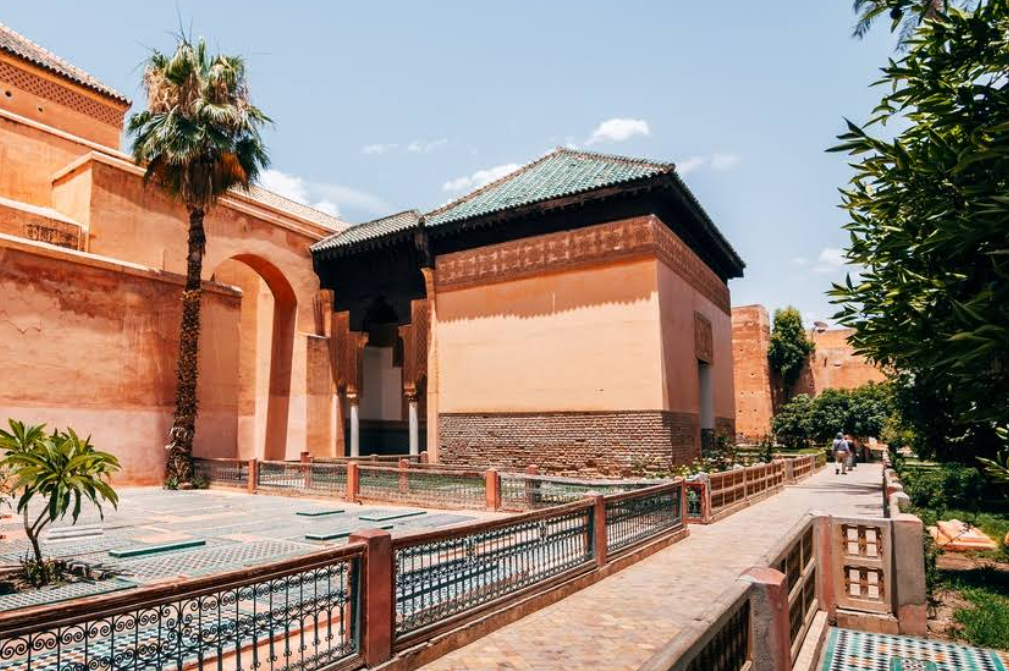
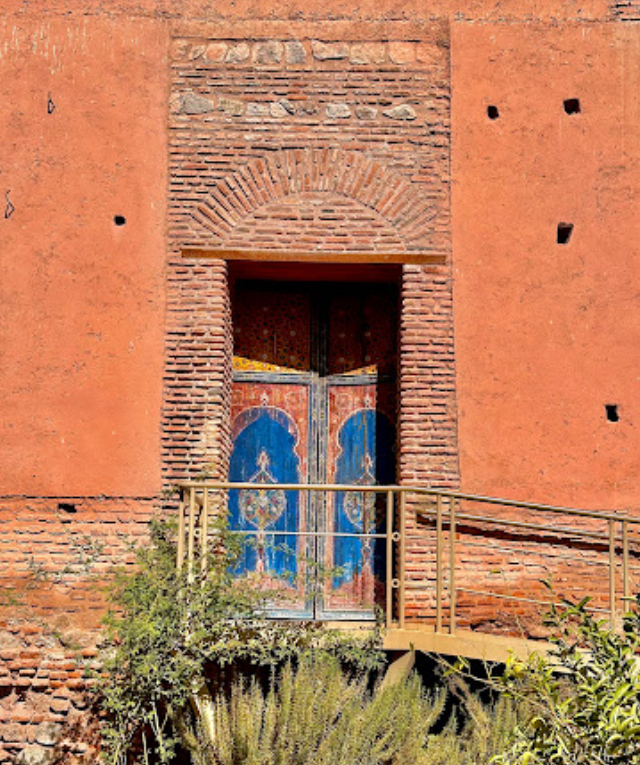

Atlas Mountains Excursion
In Part 2 of my Morocco post I will be taking you on a three day journey over the atlas mountains and through the very spine of Morocco, whilst in the city however, I firmly recommend jumping on this highly acclaimed day trip from Marrakesh, offering travellers an immersive experience into Morocco’s natural beauty and cultural heritage. This private, full-day tour typically includes:
- Scenic Drive: Journey through the picturesque Atlas Mountains, passing traditional Berber villages and terraced fields.
- Three Valleys Exploration: Visit the lush Imlil, Asni, and Ait Mizan valleys, each offering unique landscapes and insights into Berber life.
- Waterfall Hike: Embark on a guided hike to discover stunning waterfalls, with opportunities to interact with local communities.
- Camel Ride: Experience a traditional camel ride, often through scenic landscapes, providing a taste of nomadic culture.
You can choose to hike, drive, or ride mules during the tour, allowing for flexibility based on individual preferences. The excursion also offers panoramic views of the surrounding mountains and valleys, making it a memorable adventure for nature enthusiasts and explorers alike. You can book this tour through travel providers like TripAdvisor & GetYourGuide.
